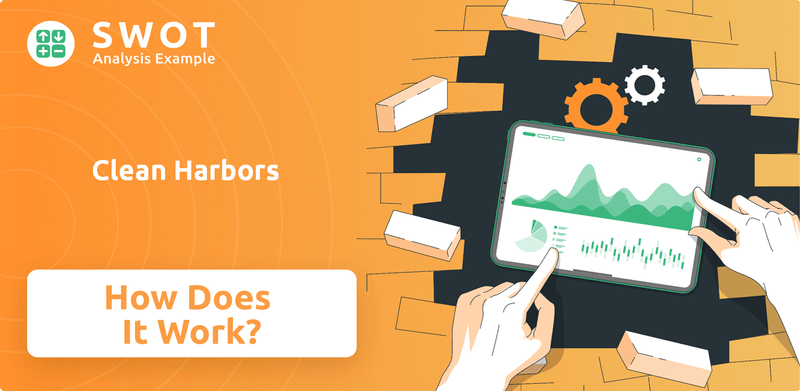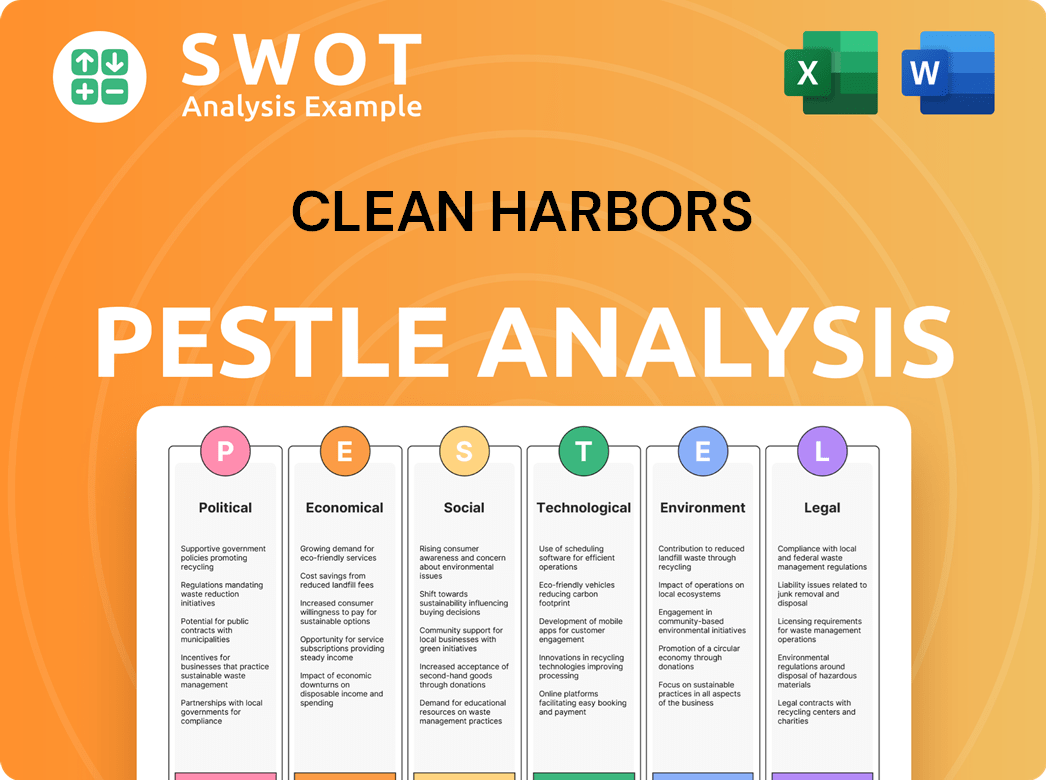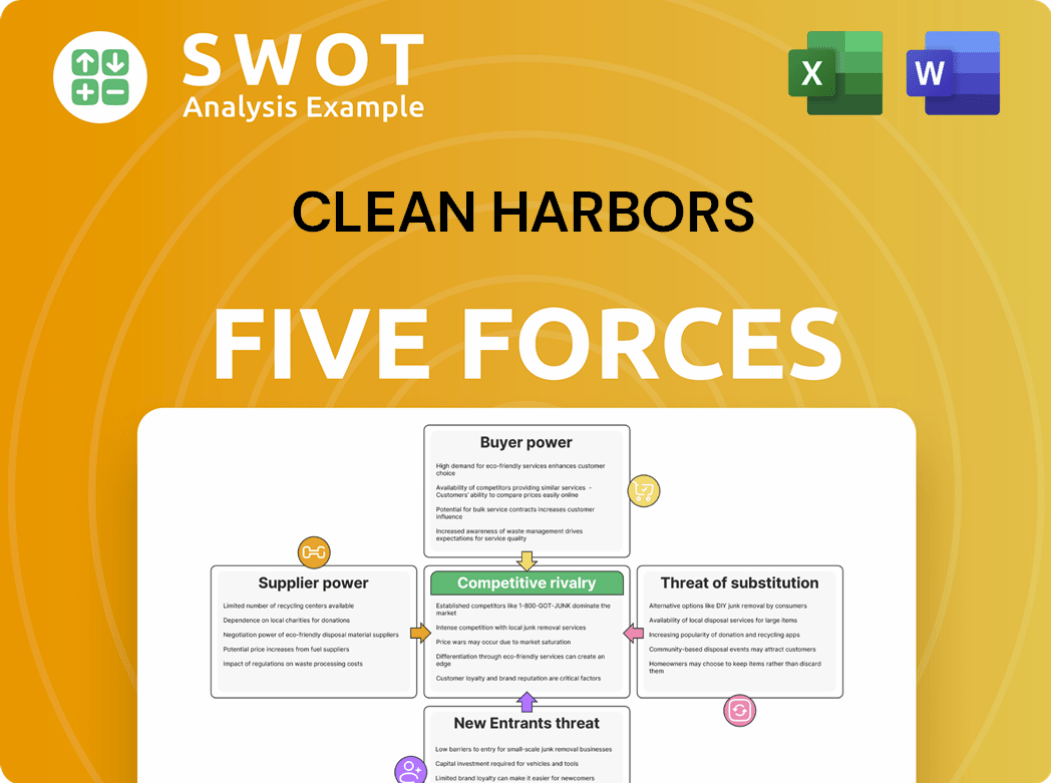Clean Harbors Bundle
How Does Clean Harbors Thrive in the Environmental Services Sector?
Clean Harbors, a dominant force in North America's environmental and industrial services, boasts impressive financial results, including record revenues of $5.89 billion in 2024. Its strategic moves, such as the launch of a state-of-the-art incinerator and key acquisitions, highlight its commitment to expanding its Clean Harbors SWOT Analysis. Serving a diverse clientele, from Fortune 500 companies to government entities, Clean Harbors is a crucial player in hazardous waste management and emergency response.

With increasing environmental regulations and a focus on sustainability, understanding Clean Harbors' operations is more critical than ever. This exploration will dissect its core business, revenue streams, and strategic initiatives, providing a comprehensive view of how Clean Harbors operates and its impact on the industry. Whether you're interested in Clean Harbors services, its waste management processes, or its role in environmental remediation, this analysis offers valuable insights.
What Are the Key Operations Driving Clean Harbors’s Success?
Clean Harbors creates value through its two main segments: Environmental Services (ES) and Safety-Kleen Sustainability Solutions (SKSS). The company offers a wide range of services, including hazardous and non-hazardous waste management. This includes collection, transportation, recycling, treatment, and disposal, making it a key player in the waste management industry.
The ES segment focuses on comprehensive waste management solutions. It operates a large network of over 100 waste disposal facilities across the United States. These facilities handle various waste streams through recycling, incineration, landfilling, and wastewater treatment. Additionally, the ES segment provides industrial and field services like cleaning, decoking, and spill response, which contribute to waste volumes within its network.
The SKSS segment is a leader in North America for re-refining and recycling used oil. It provides closed-loop solutions for recycling, reclaiming, and reusing used oil. In 2024, the company collected 253 million gallons of used oil and re-refined 249 million gallons into new base oils and lubricants. This process helps the environment by avoiding approximately 2.4 million metric tons of greenhouse gases in 2024. SKSS also offers parts washers and environmental services to various customers.
The ES segment offers a broad range of services, including hazardous and non-hazardous material management. This includes collection, packaging, transportation, recycling, treatment, and disposal. The ES segment also provides industrial and field services, such as cleaning and spill response, driving waste volumes into its disposal network.
SKSS specializes in re-refining and recycling used oil, offering closed-loop solutions. In 2024, it collected 253 million gallons of used oil and re-refined 249 million gallons. This process not only provides high-quality recycled products but also significantly reduces greenhouse gas emissions. SKSS also offers parts washers and environmental services.
Clean Harbors' vertically integrated model allows for end-to-end hazardous waste management. This comprehensive approach enables the company to offer a complete suite of environmental solutions. The company's extensive network of facilities and specialized services sets it apart from competitors.
The recent commercial launch of a new hazardous waste incinerator in Kimball, Nebraska, further enhances its capacity. This incinerator can process 70,000 tonnes annually, improving its ability to manage complex waste streams. This expansion supports the company's growth and operational capabilities.
Clean Harbors' unique approach lies in its comprehensive, vertically integrated model. This allows for complete control over the waste management process, from collection to disposal. The company's extensive network and specialized services set it apart, providing a complete suite of environmental solutions.
- Comprehensive Waste Management: Handling both hazardous and non-hazardous materials.
- Used Oil Recycling: SKSS is a leader in re-refining and recycling used oil.
- Industrial Services: Offering services like cleaning, decoking, and spill response.
- Extensive Network: Operating over 100 waste disposal facilities across the United States.
For more insights into the company's strategic direction, consider reading about the Growth Strategy of Clean Harbors.
Clean Harbors SWOT Analysis
- Complete SWOT Breakdown
- Fully Customizable
- Editable in Excel & Word
- Professional Formatting
- Investor-Ready Format

How Does Clean Harbors Make Money?
The company, a leader in environmental and industrial services, generates revenue through two main segments: Environmental Services (ES) and Safety-Kleen Sustainability Solutions (SKSS). These segments offer a wide range of services, from waste management to oil re-refining, contributing to the company's financial performance. The company's revenue streams are diverse, reflecting its comprehensive approach to environmental solutions and sustainability.
For the full year 2024, the company reported total revenues of $5.89 billion, marking a 9% increase from the previous year. The Environmental Services segment, in particular, saw strong growth, increasing its revenue by 11% during the same period. This growth highlights the company's ability to capitalize on market demands and expand its service offerings.
In the first quarter of 2025, the ES segment continued its upward trajectory, with a 3% revenue increase to $1.21 billion. The SKSS segment also showed positive results, increasing revenues by 9% to $222.7 million in Q1 2025. These figures underscore the company's resilience and strategic adaptability in the face of market challenges.
The company's revenue model is built on a foundation of diverse services and strategic initiatives. The Environmental Services segment provides a wide array of services, including hazardous waste disposal and environmental remediation services. The SKSS segment focuses on used oil re-refining, contributing to the company's sustainability efforts. The company's ability to adapt to market conditions and offer comprehensive solutions has been key to its financial success. For a deeper understanding of the company's origins and evolution, consider reading Brief History of Clean Harbors.
- Environmental Services: This segment offers hazardous and non-hazardous waste collection, treatment, disposal, recycling, emergency response, and industrial cleaning and maintenance. Field Services operations saw a significant revenue increase, partly due to acquisitions.
- Safety-Kleen Sustainability Solutions: This segment focuses on the re-refining and sale of used oil, contributing to sustainable practices. In Q1 2025, SKSS revenues increased by 9%, driven by higher volumes sold and strategic acquisitions.
- Bundled Services: The company employs bundled services to provide comprehensive waste management and environmental solutions, enhancing customer value and revenue generation.
- Sustainable Solutions: The company's focus on sustainable solutions, such as used oil re-refining, allows it to generate revenue from recovered products while meeting increasing market demand for sustainable offerings.
Clean Harbors PESTLE Analysis
- Covers All 6 PESTLE Categories
- No Research Needed – Save Hours of Work
- Built by Experts, Trusted by Consultants
- Instant Download, Ready to Use
- 100% Editable, Fully Customizable

Which Strategic Decisions Have Shaped Clean Harbors’s Business Model?
Clean Harbors has demonstrated significant growth and strategic adaptation in the environmental services sector. The company's key milestones and strategic moves highlight its commitment to expanding its operational capabilities and enhancing its market position. These actions are crucial for understanding how Clean Harbors operates and its competitive advantages in the waste management industry.
The company's strategic initiatives, including significant acquisitions and facility expansions, have been pivotal in shaping its operational scope and financial performance. These moves are driven by the need to meet the growing demands for environmental services and hazardous waste disposal. Clean Harbors continues to navigate market challenges while focusing on innovation and sustainability.
Clean Harbors' competitive edge is rooted in its extensive infrastructure, technological advancements, and commitment to safety and sustainability. These factors, combined with its strategic acquisitions and operational adjustments, position it favorably in the environmental services market. Understanding these aspects is crucial for investors and stakeholders interested in the company's long-term prospects.
A major milestone was the commercial launch of a new hazardous waste incinerator in Kimball, Nebraska, in late 2024. This facility expanded the company's incineration capacity by 70,000 tons annually. The expansion increased North American capacity by 12%, addressing the rising demand for complex waste streams.
Strategic acquisitions have been a key driver of growth for Clean Harbors. The acquisition of HEPACO in 2024 for $392.2 million significantly boosted its emergency response services. The purchase of Noble Oil Services, Inc. improved oil collection capabilities, particularly in the southeastern United States.
Clean Harbors faced challenges in the SKSS segment due to a weakening market for base oil and lubricants, which impacted profitability in Q4 2024. The company responded by transitioning to a charge-for-oil model to mitigate pricing pressures and reduce collection costs. This shift helped the segment exceed expectations in Q1 2025.
Clean Harbors' competitive advantages include an extensive network of over 100 waste facilities and proprietary technologies. The company's position as North America's largest re-refiner and recycler of used oil provides a significant edge in the sustainability sector. The company's commitment to safety is also a differentiator, achieving a Total Recordable Incident Rate (TRIR) of 0.46 in Q1 2025, its best quarterly safety result in history.
Clean Harbors is adapting to new trends, such as the growing demand for PFAS management services. The pipeline for these services is growing by an estimated 20% each quarter. This focus on innovation and sustainability is crucial for the company's long-term success.
- The new incinerator in Nebraska increases capacity and addresses complex waste needs.
- Strategic acquisitions, like HEPACO, expand service offerings and market reach.
- The company's commitment to safety and sustainability differentiates it in the market.
- Adaptation to new trends, such as PFAS management, ensures future growth.
Clean Harbors Business Model Canvas
- Complete 9-Block Business Model Canvas
- Effortlessly Communicate Your Business Strategy
- Investor-Ready BMC Format
- 100% Editable and Customizable
- Clear and Structured Layout

How Is Clean Harbors Positioning Itself for Continued Success?
As North America's leading provider of environmental and industrial services, Clean Harbors holds a significant market position. Its extensive network of over 100 waste disposal facilities and its status as the largest re-refiner of used oil highlight its operational scale. The company serves a diverse customer base, including a majority of Fortune 500 companies and government agencies, solidifying its industry leadership.
Despite its strong position, Clean Harbors faces several risks. The company operates in a highly regulated environment, making it susceptible to changes in environmental laws. Market risks, particularly fluctuations in oil prices, can impact profitability. Additionally, growth through acquisitions, while strategic, can expose the company to unknown liabilities and integration challenges. Macroeconomic softness and uncertainties regarding U.S. trade policies also pose potential headwinds.
Clean Harbors dominates the environmental services market in North America. It serves a broad customer base, including a large percentage of Fortune 500 companies. The company's extensive network and re-refining capabilities underscore its market leadership, as highlighted in Marketing Strategy of Clean Harbors.
The company is subject to environmental regulations and market fluctuations. Changes in environmental laws can increase compliance costs. Fluctuations in oil prices and demand for oil products can impact profitability, particularly for its Safety-Kleen segment.
Clean Harbors projects growth driven by strong demand and expansion initiatives. The company anticipates continued growth from its PFAS management services, seeing a multi-billion-dollar market. Further infrastructure investments are planned to support market growth.
For 2025, Clean Harbors forecasts Adjusted EBITDA between $1.15 billion and $1.21 billion, representing approximately 6% year-over-year growth. Adjusted free cash flow is expected to be between $430 million and $490 million, a nearly 30% increase from the prior year.
Clean Harbors is focused on several key initiatives for future growth and sustainability. These include expanding its Field Services business through acquisitions and investing in new infrastructure. The company is also committed to sustainability, aiming to increase the use of renewable energy.
- Ramp-up of the new Kimball incinerator.
- Expansion of Field Services through the HEPACO acquisition.
- Investing $15 million in Phoenix to support the growing semiconductor market.
- Increasing renewable energy use at its facilities by 50% by 2030 compared to its 2019 baseline.
Clean Harbors Porter's Five Forces Analysis
- Covers All 5 Competitive Forces in Detail
- Structured for Consultants, Students, and Founders
- 100% Editable in Microsoft Word & Excel
- Instant Digital Download – Use Immediately
- Compatible with Mac & PC – Fully Unlocked

Related Blogs
- What are Mission Vision & Core Values of Clean Harbors Company?
- What is Competitive Landscape of Clean Harbors Company?
- What is Growth Strategy and Future Prospects of Clean Harbors Company?
- What is Sales and Marketing Strategy of Clean Harbors Company?
- What is Brief History of Clean Harbors Company?
- Who Owns Clean Harbors Company?
- What is Customer Demographics and Target Market of Clean Harbors Company?
Disclaimer
All information, articles, and product details provided on this website are for general informational and educational purposes only. We do not claim any ownership over, nor do we intend to infringe upon, any trademarks, copyrights, logos, brand names, or other intellectual property mentioned or depicted on this site. Such intellectual property remains the property of its respective owners, and any references here are made solely for identification or informational purposes, without implying any affiliation, endorsement, or partnership.
We make no representations or warranties, express or implied, regarding the accuracy, completeness, or suitability of any content or products presented. Nothing on this website should be construed as legal, tax, investment, financial, medical, or other professional advice. In addition, no part of this site—including articles or product references—constitutes a solicitation, recommendation, endorsement, advertisement, or offer to buy or sell any securities, franchises, or other financial instruments, particularly in jurisdictions where such activity would be unlawful.
All content is of a general nature and may not address the specific circumstances of any individual or entity. It is not a substitute for professional advice or services. Any actions you take based on the information provided here are strictly at your own risk. You accept full responsibility for any decisions or outcomes arising from your use of this website and agree to release us from any liability in connection with your use of, or reliance upon, the content or products found herein.